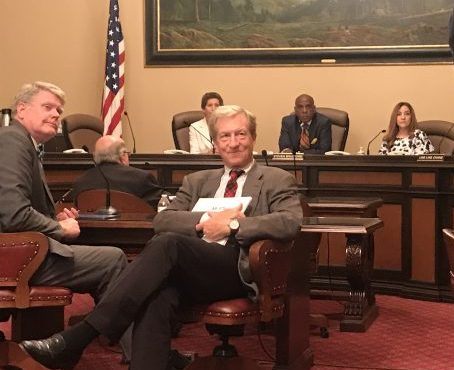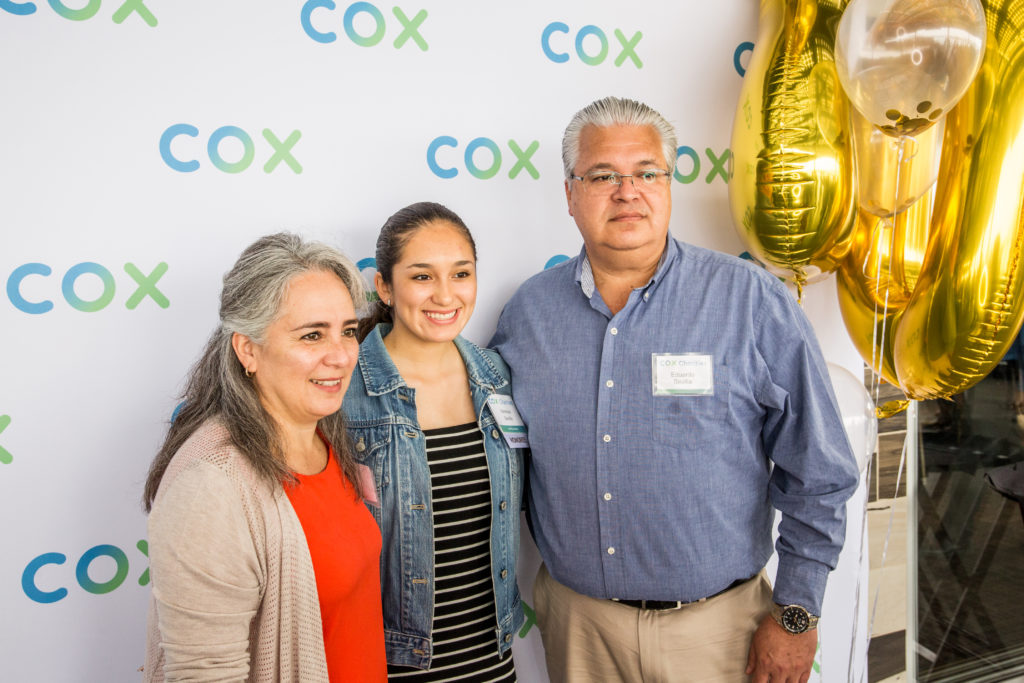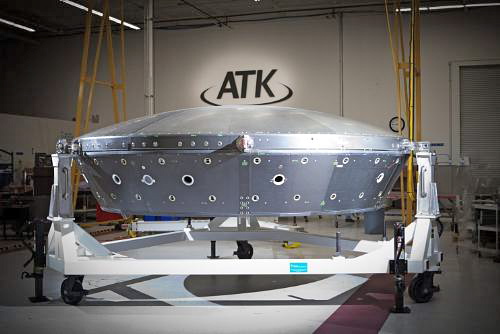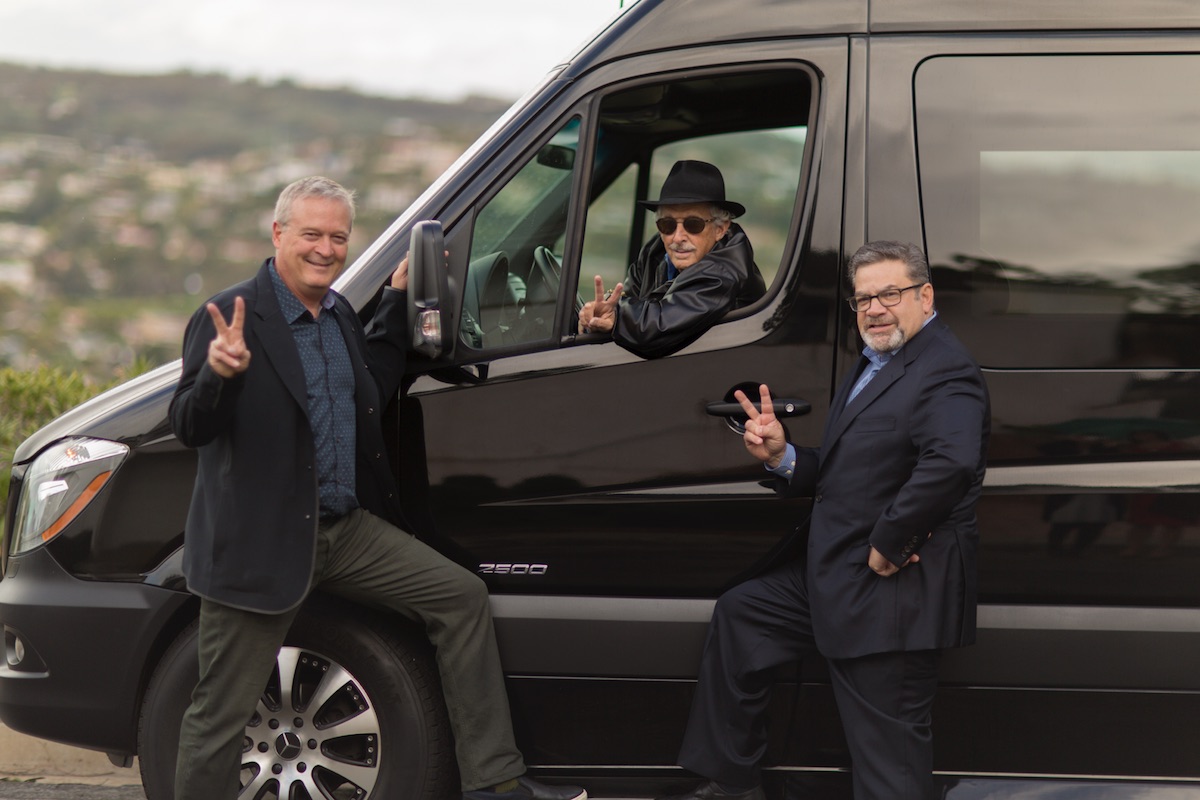Daily Business Report-June 21, 2019
The to-do list stretches as long as California’s seemingly endless blacktop, with freight as a major challenge.
‘Clean’ freight traffic is elusive
as California rolls toward zero emissions
By Julie Cart | CALmatters
Work used to be much simpler for the California Department of Transportation: widen highways, fill potholes, build new freeways.
Alas, those quaint days are gone.
To get an idea of what planners must prepare for, state officials recently hosted a demonstration of a drone air taxi that will require devising a “highway above the ground,” said Reza Navai, a Caltrans transportation planner. “If you think transportation on the ground is complex.…”
Such sci-fi-like transit is one of many high-tech changes coming as California implements its planned electrification of transportation to radically reduce greenhouse-gas emissions. The path to zero, as in zero-emission vehicles, extends well beyond flying taxis and the 5 million electric cars the state hopes will be on its roads by 2030. Everything—everything—will be replaced with an electric analog: from boats, planes and trains to delivery vans to farm tractors and even forklifts. The to-do list stretches as long as California’s seemingly endless blacktop, with freight as a major challenge.
The state’s transportation gurus envision technology that will ping driverless vehicles with an automated message when they stray from their lanes, “smart” roads that charge electric cars and trucks as they pass and an electrified Interstate 5, the West Coast’s main freight corridor. California has already widened its painted lane stripes to six inches from four so self-driving vehicles can better “see” the road. Ultimately, the highways themselves will be redesigned and constructed with different materials.
California’s transportation agency, which updates its master plan every five years, is currently preparing a look at 2050. While officials cannot predict each new technological wrinkle, Reza said, “we must be able to consider all the possibilities.”
To achieve a carbon-free transportation future, California will need to cover a lot more ground in a short time.
“If California’s trying to be a leader, we have to go as fast as possible,” said Lew Fulton, who studies sustainable transportation at UC Davis’ Institute of Transportation Studies. “Policies are critical to try to speed this up and try to push the envelope, and get all the manufacturers scared enough that they start producing what we need. Carrots and sticks. Carrots being pricing and incentives, sticks being regulatory.”
The state has spent more than $1 billion dollars in the last five years to encourage research, subsidize the exchange of internal combustion vehicles for zero-emission options, formulate cleaner fuels and expand vital charging infrastructure.
It is working with technology firms to clean up heavily polluting marine fuels belching from container ships at California ports. And state funds are helping Central Valley farmers, who are on a waiting list to crush their aging farm equipment and receive rebates to replace it with fuel-efficient models.
Such projects may get a boost from California’s Tesla-owner governor, Gavin Newsom, as budget negotiations wrap up this month. His proposed spending plan includes nearly $24 billion for all aspects of transportation, a 6% increase.
In addition, a group of legislators has expressed support for a nonprofit organization’s proposal that 15% of annual revenue from cap-and-trade auctions go to programs to clean up emissions from trucks, buses and off-road vehicles.
Few transportation modes have clean-engine options as advanced as those for passenger cars. Buses are the exception. The Chinese company BYD, manufacturing electric buses in Lancaster, is the largest in North America and has produced more than 300 buses, including nearly half of the Antelope Valley Transit Authority’s pool.
The city of Los Angeles has pledged to convert its bus fleet—second-largest in the country—to electric by 2030, though mechanical and performance problems plagued the rollout of its BYD vehicles. Many other transit districts have similar goals and include school buses. The financial burden of those commitments is softened by state vouchers for up to $200,000 toward the purchase of each zero-emission bus.
The availability of some electric all-terrain recreational vehicles, farm machinery and specialty equipment such as cherry-pickers and front-end loaders has produced niche markets. Generally, though, the readily available transportation technology stops where the road ends: Electrification of trains, planes and ships is less advanced.
______________________

State Senate Banking Committee approves
bill to aid students facing huge loan debt
Legislators took a step Wednesday toward easing burdens on students facing crushing student loan debt.
Assemblyman Mark Stone, a Santa Cruz Democrat, is carrying legislation that would institute Obama-era restrictions that have been scrapped under President Donald Trump.
- 4 million Californians hold $140 billion in debt. That’s the second-biggest debt load after home mortgages.
Stone’s “Student Borrower Bill of Rights” bill would extend to student borrowers the same protections given to people with mortgages and credit cards. It would limit past-due fees and create a state advocate to review complaints.
Opponents include bankers, the Student Loan Servicing Alliance and others who contend the legislation would raise costs by opening the way for more suits.
- Tom Steyer, the liberal billionaire activist from San Francisco, made clear the significance of the measure by testifying before the Senate Banking Committee, which approved the measure.
- Noting that some students will be paying off loans for 30 years, Steyer said: “This isn’t a partisan, Democrat-Republican issue.”
Another backer: Realtors, who see that student debt hampers the ability of college graduates to buy homes.
— Dan Morain, CALmatters
______________________
New study shows healthy gains for women
working in key positions in independent films
A new study out of San Diego State University shows 2018-19 was a record-setting year for women working in key behind-the-scenes positions in independent films.
According to a report released by Martha M. Lauzen, executive director of the Center for the Study of Women in Television and Film at SDSU, the percentages of women working as directors, writers, producers, executive producers, and editors on independent films reached recent historic highs in 2018-19.
Specifically, in the last year, 33 percent of independent film directors were women, compared to 29 percent in 2017-18. Thirty-two percent of “indie film” writers were women, up 6 percentage points from 2017-18. Women comprised 37 percent of independent film producers in 2018-19, compared to 36 percent the year prior. Additionally, this year, women accounted for 32 percent of indie executive producers and 29 percent of film editors. Both figures represent increases from the previous year.
“After many years of tracking stubbornly stagnant numbers, this year women achieved healthy gains in a number of key behind-the-scenes roles,” Lauzen said. “Despite these increases, it is important to note that women remain dramatically underrepresented, with independent films employing more than twice as many men as women in these roles.”
The study specifically looks at women’s employment on domestically and independently produced feature-length films screening at more than 20 high-profile U.S. festivals including AFI Fest, SXSW Film Festival, and Tribeca Film Festival. Overall, men comprised 68 percent of these roles and women 32 percent comparatively over the last year.
Read more…
______________________

Cox Charities presents $100,000 in grants
to 20 graduating seniors from San Diego region
Cox Charities has awarded $100,000 to 20 graduating high school seniors from around the region at the annual Cox Scholars celebration — the largest amount ever awarded by the nonprofit.
This year, graduating seniors were recognized from the following high schools:
- Grossmont Union High School District: Monte Vista High School, Helix Charter High School, Steele Canyon Charter High School
- Oceanside Unified School District: Oceanside High School
- San Diego Unified School District: Crawford High School, Morse High School, Preuss School UCSD, High Tech High Media Arts, Point Loma High School, Hoover High School, and Lincoln High School
- Sweetwater Union High School District: Otay Ranch High School (3 students!)
- Vista Unified School District: Mission Vista High School
- Independent/Private Schools: Liberty Charter High School (Lemon Grove)
Meet the 2019 Cox Scholars
The students were selected based on their academic success, community service, leadership and commitment to their education. The 2019 Cox Scholars for San Diego County are:
Grossmont Union High School District
Spring Valley resident Jeanette Chen attends Monte Vista High School. After a family member was the victim of a financial scam, Jeanette became a student ambassador through the Better Business Bureau, educating students on scams, financial literacy and credit/debit information for high school students. She plans to pursue a career in finance.
Elias Gracia will attend Swarthmore College in the fall to study behavioral economics and be the first in his family to earn a degree from a four-year university. He is passionate about the importance education has on breaking the cycle of poverty and shedding stereotypes. Gracia volunteers on a bus route through the community to help bring people to church free of charge. He currently lives in Lemon Grove and attends Helix Charter High School.
Ian Hurd doesn’t let his challenges with Asperger’s syndrome slow him down from his desire to grow and expand his horizons. Asperger’s makes it harder for the senior from Steele Canyon Charter High Schoolto read social cues and body language or make eye contact, but he has gotten out of his comfort zone and in the community such as volunteering at a food pantry for war refugees and working with children at his church’s Sunday school. Hurd, who lives in El Cajon, will major in physics.
Oceanside Unified School District
Having moved around frequently due to her father’s service in the Marines, Oceanside resident Jamarria Davis has called many places home. A student at Oceanside High School, Jamarria studied sign language and gained a better understanding of the deaf community after learning about speech pathology during a career presentation in her class. She will pursue a career as a speech pathologist.
San Diego Unified School District
Growing up in Kenya, Halimo Farah watched helplessly as her grandmother was deprived of basic medical resources due to inaccessibility. When her family came to the United States, she experienced an advanced health care system and became motivated to pursue a career in medicine. Halimo is graduating from Crawford High School and will pursue a degree in human biology.
Morse High School senior Michael Lumaban has spent his high school years in and out of homelessness, and helping to care for his ill mother and support his family while at times living in their car or hotels. At a young age, Michael had to help his disabled mother with her medicine. Job shadowing a family friend motivated him to pursue a career as a pharmacist to help others with their healthcare needs.
Bao Tram Nguyen from Preuss School UCSD will major in kinesiology to become a physical therapist and help injured athletes. She decided on her career path after being captain of her basketball team, playing with a torn ACL and helping her coach run drills and plays. When she was in second grade, her mother passed away, leaving her father to care for three young children. As the eldest sibling, Bao felt a responsibility to her sisters. The family had immigrated from Vietnam with little understanding of English. She credits her involvement in the Reality Changers program with helping her develop into a strong candidate for college.
When she majors in business, Crawford High School senior Lyaina Nguyen will be the first person in her family to go to college. A first-generation Vietnamese-American, she has a passion for creating, innovating and becoming an entrepreneur. She currently has two mentors who own their own business in the food industry, which has enabled her to gain firsthand experience in marketing, customer service and management.
Andrew Patriquin from High Tech High Media Arts plans to major in Pre-Law and pursue a career as a criminal law attorney or another field of law that serves people directly. He decided on this path after his junior year internship with a prominent San Diego criminal law attorney where he got a chance to review video evidence and police reports, prepare legal documents, and accompany his mentor in court. It was an eye-opener for Andrew on defendants’ need for representation.
Since seventh grade, Brooke Rodi from Point Loma High School has been involved in Circle of Friends, a club where students from all grades can eat lunch and play games with students who have disabilites. This year, Brooke was elected president of the club and organized an annual Unity basketball game. She has an interest in marine life and science, as well as history and sports science, and plans to explore different fields in college to better determine her career choice.
When she was younger, Margarita Rodriguez and her mother were told to speak English while they were conversing in Spanish on a bus. That experience began Margarita’s desire to major in public policy or public health and go into elected office or run her own nonprofit organization to help others. The senior from Hoover High School has also dealt with anxiety, which she was diagnosed with in middle school.
Losing her grandfather to cancer when she was in 10th grade devastated Emily Sabory. He couldn’t afford adequate medical care and he lived in Mexico, so she didn’t get to say goodbye to him. The senior from Hoover High School has a goal to become a surgeon to help others in need of medical attention.
Tristin Souvannarath from Lincoln High School plans to pursue mechanical engineering at UCLA and become a design engineer, working in the aerospace or automotive fields for his favorite companies, designing rockets for SpaceX or the Honda Civic of the future. His interest in engineering began when his dad installed SketchUp on the family computer when Tristin was four years old.
Through an internship with Include Autism, LeVan Truong from Hoover High School had an opportunity to mentor autistic children and developed a passion for human development. It also taught her to be more openminded in the diversity of how people interact with the world.
Sweetwater Union High School District
Chula Vista resident JessieLee from Otay Ranch High School will pursue a career in engineering or attend medical school in hopes of becoming a pathologist specializing in infectious diseases. When she was seven years old, Jessie received a world map that hung in her room for aesthetics. But once she began exploring the biological, chemical and environmental sciences at school, her map helped her look at the disparities in global health, especially around pathogens that invade healthy organisms. She would like to solve global health and environmental issues.
Jose Martinez, a senior at Castle Park High School in Chula Vista, will be putting his favorite subject (math) to use when he pursues a double major in engineering, specifically aerospace and mechanical engineering. When working on a research paper about aerospace engineering Jose’s lack of educational resources didn’t deter him. He reached out to an engineer from UC San Diego and an engineer at an aerospace company who provided him with additional information and support.
Vanessa Sevilla from Otay Ranch High School in Chula Vista will major in global health or neuroscience. She has suffered from depression and her sister has moderate autism, so she wanted to study a field where she could help people and assist others in managing their mental health.
As a young boy, Jedrick Zablan from Otay Ranch High School in Chula Vista lost his grandmother and aunt to cancer. The deaths of two of his mother figures led to Jedrick’s interest in the medical field. He will study microbiology in hopes of alleviating and preventing further suffering from diseases. He has two goals – one is to work for a research organization to conduct research on genetics and microbiology, and the other is to work in the Veterans Hospital helping those who made sacrifices for their country.
Vista Unified School District
Oceanside resident Ana Daniela Rojas Gallegos attends Mission Vista High School and will pursue a degree in biology so that she can make an impact in the field of medicine. She has served as the Student Board Representative for her school at Vista Unified School District board meetings, updating the board on school programs, issues and student feedback.
Independent/Private Schools
Spring Valley resident Bridget Braden from Liberty Charter High School will pursue a career in nursing, specifically in the Neonatal Intensive Care Unit (NICU). Bridget’s niece and nephew both began their lives in the NICU, so she understands how important the NICU can be to newborns and their ability survive.




